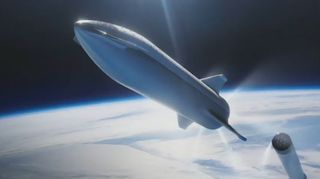
Update: SpaceX has delayed the start time of tonight's briefing by one hour. It will now begin at 9 p.m. EDT (0100 GMT).
It's that time again.
Elon Musk will unveil the latest design of SpaceX's Starship Mars-colonization architecture tonight (Sept. 28) during a presentation at the company's South Texas facilities, near the village of Boca Chica.
The talk, which will occur at 8 p.m. EDT (7 p.m. CDT, 0000 GMT), will be streamed live online. You can watch it live here at start time, as well as on Space.com's homepage. You can watch the livestream directly from SpaceX here.
The billionaire entrepreneur has given such an update every September since 2016. Much has changed since then, including the architecture's name, which shifted from the Interplanetary Transport System to the BFR to the current moniker, Starship and Super Heavy.
More: SpaceX Finishes Assembling New Starship Prototype (Photo)
Related: SpaceX's Starship and Super Heavy Mars Rocket in Pictures
Then there's size. Musk said in 2017 that the BFR will stand 348 feet (106 meters) tall. But in the tweaked design he revealed last year, the system had grown to a towering 387 feet (118 m).
Get the Space.com Newsletter
Breaking space news, the latest updates on rocket launches, skywatching events and more!
The basic design concept has held firm, however: a two-stage system that consists of a passenger-carrying vehicle (Starship in the latest iteration) stacked atop a huge rocket (Super Heavy). Both elements will be fully and rapidly reusable, Musk has said.
Starship and Super Heavy will both be powered by SpaceX's next-generation Raptor engine. The stainless-steel, 100-passenger ship will have six Raptors, whereas the first-stage rocket will boast 35 of the engines.
Or so we think now; we'll have to wait until tomorrow evening to hear if those numbers have changed.
Musk will have a nice visual aid at hand during the presentation: the newly assembled Starship Mk1, a three-engine prototype that SpaceX plans to fly for the first time in October. The Mk1, which stands 165 feet (50 m) tall, will first aim for an altitude of 12 miles (20 kilometers) and eventually conduct orbital test flights, Musk has said.
SpaceX is also building a similar vehicle, Starship Mk2, at the company's Florida facilities. The competition between the two construction efforts should end up improving the final Starship design, Musk has said.
The final Starship could take to the skies very soon, if the testing campaign continues to go well. (SpaceX has already retired its first prototype, the stubby, one-engine Starhopper vehicle.) The Starship-Super Heavy duo may start launching communication satellites as early as 2021, SpaceX representatives have said.
And Japanese billionaire Yusaku Maezawa has booked a crewed flight around the moon aboard the system, with a target launch date of 2023.
Editor's note: This story was updated to include SpaceX's webcast information for Elon Musk's Starship update.
- Elon Musk: Revolutionary Private Space Entrepreneur
- See the Evolution of SpaceX's Rockets in Pictures
- SpaceX: First Private Flights to Space Station
Mike Wall's book about the search for alien life, "Out There" (Grand Central Publishing, 2018; illustrated by Karl Tate), is out now. Follow him on Twitter @michaeldwall. Follow us on Twitter @Spacedotcom or Facebook.

Join our Space Forums to keep talking space on the latest missions, night sky and more! And if you have a news tip, correction or comment, let us know at: community@space.com.

Michael Wall is a Senior Space Writer with Space.com and joined the team in 2010. He primarily covers exoplanets, spaceflight and military space, but has been known to dabble in the space art beat. His book about the search for alien life, "Out There," was published on Nov. 13, 2018. Before becoming a science writer, Michael worked as a herpetologist and wildlife biologist. He has a Ph.D. in evolutionary biology from the University of Sydney, Australia, a bachelor's degree from the University of Arizona, and a graduate certificate in science writing from the University of California, Santa Cruz. To find out what his latest project is, you can follow Michael on Twitter.
